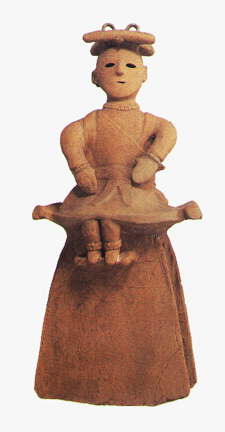
HANIWA GRAVE FIGURE OF A SEATED WOMAN IN RITUAL COSTUME, LATE KOFUN PERIOD, 400-500 CE, JAPAN, 27" HEIGHT
ART 198 - HISTORY OF WORLD CERAMICS
| Following the Yayoi period was the Kofun, literally meaning grave mound, and so named after the builders of these large tumulus graves for their rulers. Initially the haniwa were simply large cylinders placed atop the mound graves, but would evolve into large sculptural figures. Circling these mound graves were placed these terra cotta figures, which were coil built and often quite large. Usually these figures represent men and women, or animals such as horses or birds, but sometimes architectural forms such as houses or temples were made. The figure at right is thought to represent a shamaness, and she sits on a raised stool, with a cloth wrapped about her chest, wearing jewelry and a hair comb. Haniwa figures illustrate some of the characteristic features of the Japanese artistic aesthetic: unlike Chinese burial figures which were often elaborate and glazed, the haniwa were left unglazed to reveal the natural clay, and they use simple, bold, abstract form rather than detail to create an image. The figures are also thought to embody the principles of Shintoism, not technically a 'religion,' but rather the belief that 'god' permeates all things, living and non-living, and therefore, that everything is sacred. | HANIWA GRAVE FIGURE OF A SEATED WOMAN IN RITUAL COSTUME, LATE KOFUN PERIOD, 400-500 CE, JAPAN, 27" HEIGHT |
|
|